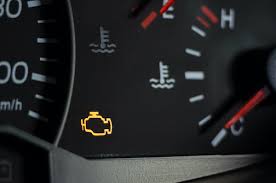When your vehicle’s blinking check engine light comes on, it’s more than just an inconvenience — it’s a clear warning that something is wrong and needs your attention immediately. Unlike a steady light that indicates a minor issue, a flashing or blinking light often points to a serious problem that could lead to engine damage if not addressed quickly.

In this article, we’ll break down what a blinking check engine light means, the most common causes behind it, how you can fix the issue, and what to do when it happens to you.
What Does a Blinking Check Engine Light Mean?
A blinking check engine light usually signals a severe engine misfire. When this happens, unburned fuel may be entering the exhaust system. This can overheat and damage the catalytic converter, a key part of your vehicle’s emissions system. Unlike a solid check engine light, which might point to a loose gas cap or minor sensor issue, a blinking light should never be ignored.
Common Causes of a Blinking Check Engine Light
Several problems can trigger a blinking check engine light. Here are the most common ones:
1. Engine Misfire
The most frequent cause is a misfiring engine. This means one or more cylinders are not firing properly. It can result from:
- Faulty spark plugs
- Worn ignition coils
- Fuel injector issues
- Poor fuel quality
2. Failed Catalytic Converter
If your catalytic converter is damaged or clogged, it won’t properly convert harmful gases into less harmful emissions. This can cause the engine light to flash and may also reduce your vehicle’s performance.
3. Bad Oxygen Sensor
The oxygen sensor monitors how much oxygen is in the exhaust gases. If it’s faulty, your engine’s computer will struggle to maintain the correct fuel-to-air ratio, which can lead to misfires and trigger a blinking warning.
4. Loose or Damaged Gas Cap
Believe it or not, a loose or broken gas cap can affect the pressure in your fuel system, triggering the light. Although it usually causes a solid light, in rare cases it may blink if the issue is serious enough.
5. Clogged Fuel Injectors
Fuel injectors spray fuel into the engine’s combustion chamber. If they’re clogged or dirty, the fuel delivery becomes uneven, which can cause a misfire and make the check engine light blink.
Why You Should Never Ignore a Blinking Check Engine Light
Ignoring a blinking check engine light could lead to expensive repairs and even engine failure. Here’s why it’s so serious:
- Permanent engine damage from overheating
- Catalytic converter failure, which is costly to replace
- Increased emissions, harming the environment
- Poor fuel economy, making your car inefficient
If your check engine light is flashing, you should treat it as an emergency. Drive as little as possible and head straight to a repair shop or mechanic.
What to Do When the Check Engine Light Starts Blinking
1. Pull Over Safely
If you’re driving and notice the check engine light blinking, pull over as soon as it’s safe. Continuing to drive could cause further damage.
2. Check the Gas Cap
It’s a simple fix, but check to make sure your gas cap is tight. Replace it if it’s cracked or worn.
3. Look for Signs of Misfire
Listen to your engine. Is it running rough? Is there a loss of power or vibration? These could be signs of a misfire.
4. Monitor Dashboard Gauges
Check your temperature and oil pressure gauges. If they’re showing abnormal readings, shut the engine off and call for help.
5. Visit a Mechanic
If you can’t identify the cause or fix it yourself, head to a qualified mechanic immediately. A professional will run a diagnostic test to pinpoint the issue.
How to Reset a Blinking Check Engine Light
Before attempting to reset the warning light, make sure the underlying issue has been resolved. Resetting the light without fixing the problem will only make things worse.
Here are two common methods to reset the check engine light:
Method 1: Using an OBD-II Scanner
- Plug the scanner into the OBD-II port (usually under the steering wheel)
- Turn the key to the “on” position (engine off)
- Use the scanner to read the codes and then select “Clear Codes”
- The light should go off if the issue has been fixed
Method 2: Disconnecting the Battery
- Turn off the car
- Disconnect the negative battery terminal
- Wait 30 seconds to 1 minute
- Reconnect the battery and restart the vehicle
Note: This method may reset other vehicle systems, such as the clock or radio presets.
When Is It Safe to Keep Driving?
In most cases, it is not safe to continue driving with a blinking check engine light. The longer you drive, the more risk you take in damaging the engine or emission components. If the light is flashing and your car is driving rough, tow it to a mechanic rather than risk additional damage.
Preventive Tips to Avoid Future Engine Light Issues
- Change spark plugs and coils as recommended
- Use high-quality fuel
- Replace the air filter regularly
- Get routine inspections and diagnostics
- Don’t ignore minor issues — they may become major
Conclusion: Don’t Ignore a Blinking Check Engine Light
Your blinking check engine light is a clear and urgent signal that something is wrong with your car’s engine or emissions system. Acting quickly can save you from expensive repairs and long-term damage. Always inspect your vehicle right away or take it to a trusted mechanic for a proper diagnosis.
If you’re unsure what to do or don’t have the tools to diagnose the issue yourself, visit your nearest auto repair center. Ignoring a blinking light could cost you far more than just a quick fix — so take it seriously.
